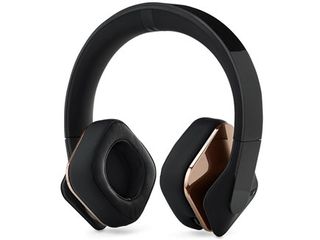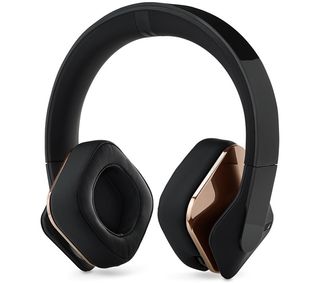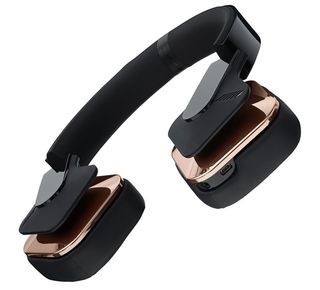Alpine Over-Ear Headphones Review
The Alpine Over-Ear Headphones add a layer of depth to your music via vibration technology, and have a unique, lightweight design.
Why you can trust Tom's Guide

Known for its in-car audio tech, including amplifiers and subwoofers, Alpine Electronics is now tackling the world of high-end headphones. The $299 Alpine Over-Ear headphones offer the company's proprietary vibrating TKR3 (Tuned Kinect Resonance 3) technology, which adds a feeling of total audio immersion. If that isn't enough, the headphones work in tandem with the free Level app, which creates playlists based on beats per minute. It takes the concept of feeling your music to a whole new level.
Design
The Alpines are intriguing headphones. For starters, the ear caps are shaped like parallelograms with rounded corners. Even the faux-leather cups with their memory-foam lining are diamond shaped.
MORE: Best Headphones to Buy Now
The exterior caps, like the majority of the frame, are made from a white matte plastic whose slightly textured finish creates a sturdy grip. The interior caps are made from plastic with a dark-gray chrome finish. The band itself is rather thick compared to most headphones on the market, but I like the soft, squishy underside, as it's comfortable and wicks away sweat.

Each earcup has a chrome Alpine emblem embedded along the side. I was surprised to see that the company didn't mark the earcups to distinguish which side is left and which is right. That left me to assume that the side with the microUSB port, audio jack and power button was the left cup, but your guess is as good as mine. Both caps can rotate 90 degrees, allowing the headphones to lay flat for easy storage in the accompanying black pouch.
Comfort
These headphones are lighter than they look. Despite their relatively bulky appearance, the Alpine headphones weigh a manageable 13.4 ounces. By comparison, the Razer Kraken Forged Edition headphones weigh 13.75 ounces, but the Skullcandy Crushers are a lighter 8.35 ounces.
I noticed a little pressure around my ears when I initially put the headphones on, but the Alpines are not nearly as tight as the Skullcandy Crushers.
MORE: Best Noise-Canceling Headphones
Once I adjusted the ear cups, I wore the Alpines for more than two hours without complaint.
Music You Can Feel
Like Meghan Trainor, the Alpine headphones are all about the bass. The cans use TKR3, an Alpine-patented technology that simulates the feeling of a live performance. That means when I was listening to Ludacris' "One More Drink," I felt a subtle thump accompanying the heavy low-end. It's not enough to be jarring, but it was strong enough to enhance the bass and add a sense of depth.

The headphones really shine when you're listening to music recorded live. Erykah Badu's live performance of "On & On" gained dimension with TKR3 engaged. Closing my eyes, letting the luscious bass and the singer's powerful alto wash over me, I felt like I was sitting in a concert hall. The soundscape felt closer and sounded much warmer than it did with the technology disabled.
The Skullcandy Crushers and their Sensation 55 driver, by contrast, produced a skull-rattling effect, combined with bass that was distracting when set to high. On low, the Crushers were on a par with the Alpines, but were at their best when set to medium, delivering a vibrating bass that was satisfying, deep and warm. The Alpines' pulsating lows felt and sounded weak by comparison.
When listening to music, I preferred the Alpines' subtle vibration to the Crushers' full-on assault. However, if I'm playing a game lousy with explosions, the Crushers provide a dimension of gravity that can't be beat.
Performance
Word to the wise, the Alpines are great at kicking sound out, but not so much when it comes to keeping it in. As I was listening to Jay Z's "D.O.A." at higher volumes, my colleague tapped me on the shoulder to inform me he could hear every word of the song and was about to start rapping along.
After relocating to a quiet room, I noticed that the Alpines produced rather clear violins, but the bass guitar sounded muddy with TKR3 enabled. The Crushers' heavy-handed approach to bass made for a muddled mess when vibration was enabled.
When the vibrating bass boost was disabled on both sets of cans, I found the Alpines delivered richer, fuller bass compared to the Crushers.

I wanted to check out something a bit more angsty, so I switched to the Guns N' Roses classic "November Rain." Without TKR3 enabled, the Alpines delivered sensual strings with powerful piano over Axl Rose's tortured vocals. I was impressed by the clarity of the flutes and cymbals in the background. The Crushers also produced a fairly balanced performance, but Rose sounded as if he were singing from behind a wall. And without the Sensation 55 driver activated, the lows were noticeably thin.
Switching on the Alpines' subtle rumble diluted the track's clarity. The previously clear piano now fought for space with the violins, and Slash's searing guitar solo lost some of its punch. However, the Crushers' artificial bass overwhelmed the background singers and more delicate pieces of the song.
Level Play App
This set of headphones is one of the latest to be accompanied by a smartphone app. Dubbed "Level Play," the free iOS-exclusive app aggregates your downloaded tracks into playlists based on energy levels. Alpine markets the app as a new way to create playlists and experience your music. I accomplished this pretty easily by pressing the shuffle button, but that's just me.
Unfortunately, fans of streaming services such as Spotify and Pandora are out of luck on this one. The app's three levels are broken out by intensity — high, medium and low — and are determined using beats per minute (BPM).
After I quickly paired the app with the Alpines and selected which intensity level I was in the mood for, I was good to go. When it was time to change levels, I long-pressed the Level Play tab and tapped the corresponding mode to access my new playlist. The app did a fairly good job categorizing songs into their respective places on the energy spectrum.
I found some of my favorite slow jams, including Janet Jackson's "Funny How Time Flies (When We're Having Fun)", EnVogue's "Don't Let Go (Love)" and Usher's "Here I Stand," in the low-intensity playlist, while Nas' "Dr. Knockboot" found its way into my high-intensity list.
However, there were a few miscategorizations. For example, Ciara's upbeat club anthem "One, Two Step" found its way into low intensity, while Evanescence's "My Immortal" was shuffled into high. Thankfully, you can assign songs to a new energy level by swiping to the right on a chosen track.
In addition to creating BPM-based playlists, Level Play has an equalizer that I used to create custom settings for a few songs in my catalog. After accessing the Sound tab in the menu, I simply dragged the five sliders into position. If I went too far in my audio machinations, a quick tap of the Reset icon restored the settings to their default positions.

The app also allows you to share your favorite songs on Facebook or tag parts of a song for later listening. You can perform more pedestrian functions such as advancing or rewinding a track by dragging your finger right or left over a running song. You can also adjust the volume using the app. And in case you were wondering, the volume goes up to 11. Somewhere, Nigel is smiling.
Bluetooth and Battery Life
Outside of pairing the Alpines to your smartphone or tablet to use the Level Play app, you won't be using the headphones' Bluetooth 4.0 LE that much. The Alpines are unable to stream music over Bluetooth, so the gentle thump of the TKR3 technology consumes the bulk of the battery. Alpine says its battery should last for up to 10 hours; fortunately, the headphones will still work after that—you just won’t get the rumble.
Skullcandy employs a single AA-battery to power the Crushers' Sensation 55 driver and estimates the headphones' battery life at 40 hours.
Bottom Line
When it comes to adding vibrating bass to your music, less is always more, which is why I appreciate Alpine's measured approach to its rumble technology. The $299 Alpine headphones produce loud, clear audio that's enhanced when the pulsing lows are added. It's a neat effect that, when paired with the comfortable frame, makes for a pleasurable listening experience, especially on live recordings. The Level App is a novel way to create playlists, but I wish the BPM categorizations were more precise. Also I wish the app were available for Android.
Music lovers looking for a more pronounced bass effect while saving a few bucks will want to check out the Skullcandy Crusher headphones. At $99, they're significantly cheaper than the Alpines. However, for all that extraneous thump you gain, you lose a lot of clarity and details. Overall, the Alpines are a solid choice for music lovers looking for headphones with an interesting design, good audio quality and an immersive live experience.
Follow Sherri L. Smith @misssmith11 and on Google+. Follow us @TomsGuide, on Facebook and on Google+.
Sign up to get the BEST of Tom’s Guide direct to your inbox.
Upgrade your life with a daily dose of the biggest tech news, lifestyle hacks and our curated analysis. Be the first to know about cutting-edge gadgets and the hottest deals.
Sherri L. Smith has been cranking out product reviews for Laptopmag.com since 2011. In that time, she's reviewed more than her share of laptops, tablets, smartphones and everything in between. The resident gamer and audio junkie, Sherri was previously a managing editor for Black Web 2.0 and contributed to BET.Com and Popgadget.

